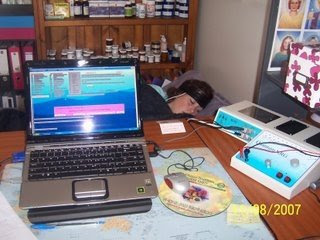
signal detection: In this first phase the patient is placed electrodes (probes or sensors) charge to register or pick up the signal at the place where it is produced by the subject and pass into the biofeedback machine, where the same shall be subjected to various subsequent operations in order to make the signal is useful and manageable.
There are basically two detection techniques: invasive and noninvasive techniques. In the first recording electrodes are inserted into the subject through a small surgical procedure, in order to bring them as close as possible to the physiological system will be registered. In the noninvasive recording electrodes are placed on the skin surface above the physiological system to be evaluated.
physiological activity produced by the body and recorded by the electrodes can be an electrical signal directly in the form of an electrical potential (electrocardiogram, electroencephalogram, electromyogram, etc.).
In other cases, the detected signal is a simple electrical property of the system by subjecting it to special handling, such as, for example, the resistance of the skin to be applied to it a small electrical current . These signals are called bioelectric signals transduced.
A third group are the natural biological signals are simply physical phenomena or physical or mechanical properties associated with certain phenomena that can be converted into electrical signals to be processed from registration with conventional physical or mechanical methods (temperature, blood pressure, movement, etc).
Amplification: the signal captured by the recording electrodes from a physiological response or process issued by a subject is transmitted into the biofeedback machine to be processed or analyzed, but given the usual low physiological signals is necessary to amplify them with minimal distortion as possible to carry out this analysis. The amplification was basically operates on the magnitude and extent of physiological response, being able to regulate the degree of amplification required by the control of gain or sensitivity that includes the external panel unit's control.
Processing and filtering of the signal: normally, the signal captured by the recording electrodes is not a pure signal, but, with this signal, the device can capture a multitude of strange signs and electric potential, from various sources outside the signal Bioelectrical we wish to evaluate. These interfering signals are called noise or artifacts
. To eliminate noise or artifacts, the input signal detected by the device and is pre-amplified
filtered according to different frequency ranges in order to reject them based on signs / devices whose frequencies are above or below frequency band in which occurs the bioelectrical signal to be registered. Regarding
processing there are different types, the most common are:
integration and response threshold. integration is simplification of the signal Feedback accumulating and averaging isolated sets of signals produced in a given period of time in a unique signal that represents the area or set of individual signals, as they are produced directly by the subject. On the other side. response threshold functions through the provision of information or feedback to the subject only when the signal crosses above or below, as appropriate, to a certain extent previously established in the corresponding knob on the dashboard.
signal conversion: is the transformation of the electrical signal in susceptible sensory signals or power be perceived and evaluated by the subject, being the most frequent visual or auditory sensory modalities.
Providing information and feedback to the subject: this last phase takes into account two important aspects to consider. The first is the mode of quantitative information, where information on the physiological response is given to the subject for example, within the visual modality, in a series of digits or the movement of a needle on a dial or sliding scale or, on the contrary, the information can be qualitative, for example, in a series of colored lights that are illuminated or extinguished as it progresses on the level of response the subject.
For the auditory modality is more often present feedback as a tone whose frequency and intensity vary according to variations in the level of response being recorded and submitted to the process of biofeedback.
Another important aspect is the amount of information provided to the subject by means of feedback for which there are two ways, the analog and binary, the first is when each feedback stimulus value corresponds to an equivalent of the response evaluated , there is a direct relationship between them. In the binary feedback, however, the stimulus has only two states whose limit has been established before a certain level, so the only information given to the subject is only if your response rate is above or below the set criteria, therefore, provides much less information than the analog feedback.
























